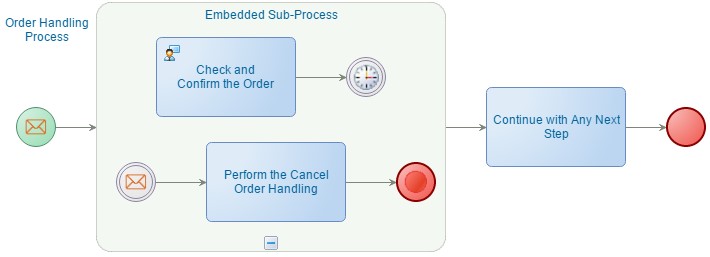Part 3: Business scenario: Inter-process communication (OT PS)

Customers are placing orders in your shop, but within a limited amount of time they have the right to cancel the order for whatever reason.
In your business process model for the Order Handling process, you have modelled two separate flows grouped as an Embedded Sub-process serving as the “context” in which both flows simultaneously are executed. One flow contains the ordinary steps for handling and processing the order and the other allows for cancelling the order. By adding a delay to the normal flow, you are able to specify the maximum time for cancelling the order, this can be a calculated value as well.

Using the Embedded Sub-Process construct, both flows will be initiated when the process is started. A business identifier to contain for example the order number is added to both processes, the sender process as well as the receiver process. The cancel order process is simple and takes the order number as input. This process can be generated as a web service operation allowing the customer to execute the service in order to cancel the related order (process instance).

Note that only with the Order Handling process you define the cancel order message that must be received in the Receive Message event. In the Cancel Order process at the Send Message event you identify the specific order process by means of the before mentioned business identifier, in this case called theOrderNumber. And refer to the cancel order message as defined with the Order Handling process.
Download a copy of a workspace to illustrate this scenario
The OpenText Process Suite (OpenText Cordys) Boot Camp Tour starts September 2015. Register your interest today for a chance to qualify for our Early Bird price plan.
Coming up in this blog series:
- Part 4: Inter-process communication workspace
Previous post from this blog series:


